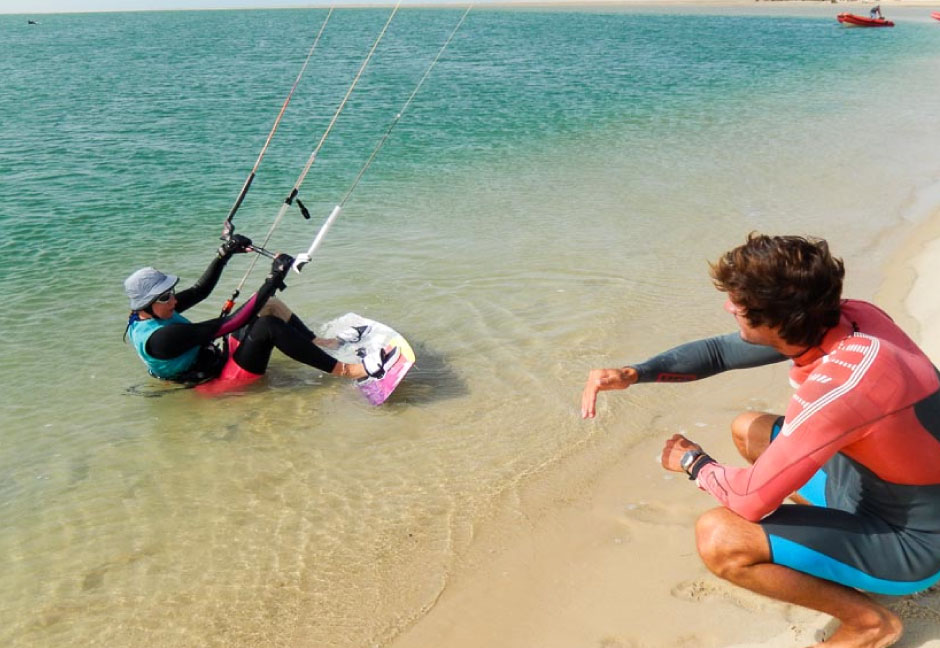Kitesurfing or kiteboarding has become the most popular water and wind sport a few years ago.
Why learn kitesurfing?
We could say that the main reasons why it has become such a popular sport and that every year is practiced by more and more people would be:
- Easy to learn. You will have to spend hours learning, but before the tide goes out you will be on your board.
- Relatively safe. Kitesurfing is not that dangerous. Obviously there are risks as in all extreme sports and here, being conditioned by the force of the wind and / or natural forces can be an extra danger, but if you do things correctly, take the courses and practice with caution, the kite does not have to be dangerous. All the equipment and safety systems in the last 10 years have evolved by leaps and bounds, making this sport quite safe, if you know what you are doing.
- Dynamic. Very dynamic compared to other sports. You will always be on the move, never stop learning and trying new tricks or switching to other disciplines. The dynamism and possibilities are so high that you will never get bored or think you are stuck.
- Addictive. When you try kitesurfing you become dependent on the wind, you become an expert meteorologist in order to get your fix. The sensation of gliding, together with the connection with the natural environment, flying high and the freedom it gives you, will invade you with a feeling of fullness and wellbeing like rarely before. Something different and unique within your reach.
If you want to learn kitesurfing you must do it with a school and qualified and specialised teachers. You should take your kitesurfing lesson and not try to learn on your own. A teacher will not only make you learn quickly, but will make the practice 100% safe for you and those around you.
What equipment is used in kitesurfing?
It is essential to know and then have good kite equipment. This is what you need to learn kitesurfing:
The kitesurfing kite
The star element that differentiates it from other types of sports. There are many different types and models. And of course, the brands have thought about those people who want to start and for them they have designed specific models that will make it much easier to start and progress.
The kitesurf board
The most used type of board, both for learning and practising, is the twintip. This board is bi-directional, which means that you can kite in both directions without changing the position of your feet. It is a symmetrical board, unlike a conventional surfboard, which would be directional, with a bow (front, nose) and a stern (back, tail).
The kitesurfing bar or control system
It will be our steering wheel and all the safety systems are integrated in it, so you have to pay a lot of attention to it, know everything perfectly and put it into practice again and again. Independent but linked to the harness and the bar is the leash, which is a simple extra safety strap that connects to the harness and to one of the kite’s connection lines.
The kitesurfing harness
Our connection to the kite. Here we differentiate between two main types. The seat harness, used in learning and those riders who want it and the waist harness. More common once the technique is mastered with some ease.
We must also highlight the use of kitesurfing wetsuit (a must), helmet, lifejacket or impact waistcoat.
Where to learn it?
Dakhla Kitesurf Hotels
The city of Dakhla is a narrow peninsula 50 km long located on the Atlantic coast of Morocco. Its immense lagoon of turquoise flat water, waves on the Atlantic side, its constant wind all year round, its traditions, its microclimate… so many elements that make Dakhla one of the most exceptional places in the world for water sports.
The Dakhla lagoon is a small paradise for kitesurfing enthusiasts. Its geographical location, its constant wind, its flat water and even though it is in the middle of the desert, its temperature does not exceed 27ºC all year round.
With Dakhla Kitesurf Hotels, you can book semi-private or private lessons or equipment hire according to your level. We propose personalised offers for each level.







